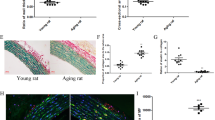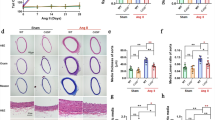Abstract
Testosterone deficiency is associated with a higher incidence of cardiovascular diseases in men. However, its effect on cell senescence, which plays a causal role in vascular aging, remains unclear. Here, we tested the hypothesis that testosterone alleviated vascular smooth muscle cell (VSMC) senescence and collagen synthesis via growth arrest-specific protein 6 (Gas6)/Axl- and Akt/FoxO1a-dependent pathways. Testosterone significantly ameliorated angiotensin II-induced VSMC senescence and collagen overexpression. In addition, testosterone inhibited angiotensin II-induced matrix metalloproteinase-2 (MMP-2) activity, which played a pivotal role in facilitating age-related collagen deposition. Testosterone increased the expression of tissue inhibitor of metalloproteinase-2 but decreased the expression of MMP-2 and membrane type-1 metalloproteinase which contributed to increase MMP-2 activity. The effects on VSMCs senescence and collagen synthesis were mediated by restoration of angiotensin II-induced downregulation of Gas6 and Axl expression and a subsequent reduction of Akt and FoxO1a phosphorylation. The effects of testosterone were reversed by a Gas6 blocker, Axl-Fc, and a specific inhibitor of Axl, R428. Treatment of VSMCs with PI3K inhibitor LY294002 abrogated the downregulating effect of testosterone on MMP-2 activity. Furthermore, when FoxO1a expression was silenced by using a specific siRNA, the inhibitory effect of testosterone on MMP-2 activity was revered as well, that indicated this process was Akt/FoxO1a dependence. Taken together, Gas6/Axl and Akt/FoxO1a were involved in protective effects of testosterone on VSMCs senescence and collagen synthesis. Our results provide a novel mechanism underlying the protective effect of testosterone on vascular aging and may serve as a theoretical basis for testosterone replacement therapy.






Similar content being viewed by others
References
Campisi J (2005) Senescent cells, tumor suppression, and organismal aging: good citizens, bad neighbors. Cell 120:513–522. doi:10.1016/j.cell.2005.02.003
Ganopolsky JG, Abid MR, Aird WC, Blostein MD (2008) GAS6-induced signaling in human endothelial cells is mediated by FOXO1a. J Thromb Haemost 6:1804–1811. doi:10.1111/j.1538-7836.2008.03114.x
Gao BB, Stuart L, Feener EP (2008) Label-free quantitative analysis of one-dimensional PAGE LC/MS/MS proteome: application on angiotensin II-stimulated smooth muscle cells secretome. Mol Cell Proteomics 7:2399–2409. doi:10.1074/mcp.M800104-MCP200
Goberdhan P, Dimri, et al. (1995) A biomarker that identifies senescent human cells in culture and in aging skin in vivo. Proc Natl Acad Sci U S A 92(20):9363–9367
Guo D et al. (2010) Loss of PI3Kgamma enhances cAMP-dependent MMP remodeling of the myocardial N-cadherin adhesion complexes and extracellular matrix in response to early biomechanical stress. Circ Res 107:1275–1289. doi:10.1161/CIRCRESAHA.110.229054
Herbert KE, Mistry Y, Hastings R, Poolman T, Niklason L, Williams B (2008) Angiotensin II-mediated oxidative DNA damage accelerates cellular senescence in cultured human vascular smooth muscle cells via telomere-dependent and independent pathways. Circ Res 102:201–208. doi:10.1161/CIRCRESAHA.107.158626
Hung YJ, Lee CH, Chu NF, Shieh YS (2010) Plasma protein growth arrest-specific 6 levels are associated with altered glucose tolerance, inflammation, and endothelial dysfunction. Diabete Care 33:1840–1844. doi:10.2337/dc09-1073
Hurtado B et al. (2010) Association study between polymorphims in GAS6-TAM genes and carotid atherosclerosis. Thromb Haemost 104:592–598. doi:10.1160/TH09-11-0787
Hurtado B et al. (2011) Expression of the vitamin K-dependent proteins GAS6 and protein S and the TAM receptor tyrosine kinases in human atherosclerotic carotid plaques. Thromb Haemost 105:873–882. doi:10.1160/TH10-10-0630
Jiang L, Zhang J, Monticone RE, Telljohann R, Wu J, Wang M, Lakatta EG (2012) Calpain-1 regulation of matrix metalloproteinase 2 activity in vascular smooth muscle cells facilitates age-associated aortic wall calcification and fibrosis. Hypertension 60:1192–1199. doi:10.1161/HYPERTENSIONAHA.112.196840
Jin CW et al. (2015) Gas6 delays senescence in vascular smooth muscle cells through the PI3K/Akt/FoxO signaling pathway. Cell Physiol Biochem 35:1151–1166. doi:10.1159/000373940
Jones TH, Saad F (2009) The effects of testosterone on risk factors for, and the mediators of, the atherosclerotic process. Atherosclerosis 207:318–327. doi:10.1016/j.atherosclerosis.2009.04.016
Jones RD, Nettleship JE, Kapoor D, Jones HT, Channer KS (2005) Testosterone and atherosclerosis in aging men: purported association and clinical implications. Am J Cardiovasc Drugs 5:141–154
Kadri Z et al. (2005) Phosphatidylinositol 3-kinase/Akt induced by erythropoietin renders the erythroid differentiation factor GATA-1 competent for TIMP-1 gene transactivation. Mol Cell Biol 25:7412–7422. doi:10.1128/MCB.25.17.7412-7422.2005
Korshunov VA, Mohan AM, Georger MA, Berk BC (2006) Axl, a receptor tyrosine kinase, mediates flow-induced vascular remodeling. Circ Res 98:1446–1452. doi:10.1161/01.RES.0000223322.16149.9a
Kovacic JC, Moreno P, Hachinski V, Nabel EG, Fuster V (2011a) Cellular senescence, vascular disease, and aging: part 1 of a 2-part review. Circulation 123:1650–1660. doi:10.1161/CIRCULATIONAHA.110.007021
Kovacic JC, Moreno P, Nabel EG, Hachinski V, Fuster V (2011b) Cellular senescence, vascular disease, and aging: part 2 of a 2-part review: clinical vascular disease in the elderly. Circulation 123:1900–1910. doi:10.1161/CIRCULATIONAHA.110.009118
Kunieda T et al. (2006) Angiotensin II induces premature senescence of vascular smooth muscle cells and accelerates the development of atherosclerosis via a p21-dependent pathway. Circulation 114:953–960. doi:10.1161/CIRCULATIONAHA.106.626606
Lakatta EG (2003) Arterial and cardiac aging: major shareholders in cardiovascular disease enterprises: part III: cellular and molecular clues to heart and arterial aging. Circulation 107:490–497. doi:10.1161/01.CIR.0000048894.99865.02
Lakatta EG, Levy D (2003) Arterial and cardiac aging: major shareholders in cardiovascular disease enterprises: part I: aging arteries: a “Set up” for vascular disease. Circulation 107:139–146. doi:10.1161/01.cir.0000048892.83521.58
Lemke G (2013) Biology of the TAM receptors. Cold Spring Harb Perspect Biol 5:a009076. doi:10.1101/cshperspect.a009076
Lopes RA, Neves KB, Carneiro FS, Tostes RC (2012) Testosterone and vascular function in aging. Front Physiol 3:89. doi:10.3389/fphys.2012.00089
Lutgens E et al. (2008) Genetic loss of Gas6 induces plaque stability in experimental atherosclerosis. J Pathol 216:55–63. doi:10.1002/path.2381
Minamino T, Komuro I (2007) Vascular cell senescence: contribution to atherosclerosis. Circ Res 100:15–26. doi:10.1161/01.RES.0000256837.40544.4a
Munoz X, Obach V, Hurtado B, de Frutos PG, Chamorro A, Sala N (2007) Association of specific haplotypes of GAS6 gene with stroke. Thromb Haemost 98:406–412
Nguyen Dinh Cat A, Montezano AC, Burger D, Touyz RM (2013) Angiotensin II, NADPH oxidase, and redox signaling in the vasculature. Antioxid Redox Signal 19:1110–1120. doi:10.1089/ars.2012.4641
Schneider C, King RM, Philipson L (1988) Genes specifically expressed at growth arrest of mammalian cells. Cell 54:787–793
Seyrek M, Yildiz O, Ulusoy HB, Yildirim V (2007) Testosterone relaxes isolated human radial artery by potassium channel opening action. J Pharmacol Sci 103:309–316
Sharma R et al. (2015) Normalization of testosterone level is associated with reduced incidence of myocardial infarction and mortality in men. Eur Heart J. doi:10.1093/eurheartj/ehv346
Shen YH et al. (2013) AKT2 confers protection against aortic aneurysms and dissections. Circ Res 112:618–632. doi:10.1161/CIRCRESAHA.112.300735
Son BK et al. (2010) Androgen receptor-dependent transactivation of growth arrest-specific gene 6 mediates inhibitory effects of testosterone on vascular calcification. J Biol Chem 285:7537–7544. doi:10.1074/jbc.M109.055087
Vlachopoulos C et al. (2014) Testosterone deficiency: a determinant of aortic stiffness in men. Atherosclerosis 233:278–283. doi:10.1016/j.atherosclerosis.2013.12.010
Wang JC, Bennett M (2012) Aging and atherosclerosis: mechanisms, functional consequences, and potential therapeutics for cellular senescence. Circ Res 111:245–259. doi:10.1161/CIRCRESAHA.111.261388
Wang M et al. (2003) Aging increases aortic MMP-2 activity and angiotensin II in nonhuman primates. Hypertension 41:1308–1316. doi:10.1161/01.HYP.0000073843.56046.45
Wang M et al. (2012) Chronic matrix metalloproteinase inhibition retards age-associated arterial proinflammation and increase in blood pressure. Hypertension 60:459–466. doi:10.1161/HYPERTENSIONAHA.112.191270
Wang M, Jiang L, Monticone RE, Lakatta EG (2014) Proinflammation: the key to arterial aging. Trends Endocrinol Metab 25:72–79. doi:10.1016/j.tem.2013.10.002
Yildiz O (2007a) Vascular smooth muscle and endothelial functions in aging. Ann N Y Acad Sci 1100:353–360. doi:10.1196/annals.1395.038
Yildiz O, Seyrek M (2007b) Vasodilating mechanisms of testosterone. Exp Clin Endocrinol Diabetes 115:1–6. doi:10.1055/s-2007-949657
Acknowledgments
This work was supported by the research grants from the National Basic Research Program of China (973 Program, Grant No. 2013CB530700), the National Natural Science Foundation of China (81100605, 81270352, 81270287, 81300168, 81471036, 81470560, and 81570400), the Natural Science Foundation of Shandong Province (BS2013YY017, ZR2014HQ037), the Key Research and Development Program of Shandong Province (2015GSF118062), cardiovascular exploration research foundation of Chinese Medical Doctor Association (DFCMDA201320), and the Specialized Research Fund for the Doctoral Program of Higher Education (SRFDP 20130131120065).
Author information
Authors and Affiliations
Corresponding authors
Ethics declarations
Conflict of interest
The authors declare that they have no competing interests.
Electronic supplementary material
ESM 1
The primary data of Fig. 1 (GIF 260 kb)
ESM 2
The primary data of Fig. 2 (GIF 303 kb)
ESM 3
The primary data of Fig. 3 (GIF 205 kb)
ESM 4
The primary data of Fig. 4 (GIF 200 kb)
ESM 5
The primary data of Fig. 5 (GIF 254 kb)
ESM 6
The primary data of Fig. 6 (GIF 227 kb)
ESM 7
The primary data of ESM 8 (GIF 88 kb)
ESM 8
The Akt signaling pathway is involved in the anti-senescence effect of testosterone (A) The PI3K inhibitor, LY294002 could reverse the downregulating effects of testosterone on the expression of p16INK4a and p21Cip1 (P<0.05) induced by angiotensin II. But the regulating effect of LY294002 on p16INK4a expression was much weaker. Angiotensin II (Ang II), testosterone (T). Values are mean±SD of three measurements. *P<0.05 and **P<0.01 compared with control group; #P<0.05 and ##P<0.01compared with angiotensin II-treated group; †P<0.05 compared with testosterone-treated group (GIF 54 kb)
About this article
Cite this article
Chen, Yq., Zhao, J., Jin, Cw. et al. Testosterone delays vascular smooth muscle cell senescence and inhibits collagen synthesis via the Gas6/Axl signaling pathway. AGE 38, 60 (2016). https://doi.org/10.1007/s11357-016-9910-5
Received:
Accepted:
Published:
DOI: https://doi.org/10.1007/s11357-016-9910-5




